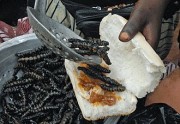Was I writing about exotic sources of vegetable fats? I was. I went off there down the Shorea robusta [Sal] rabbit-hole pretending that I knew enough about shea butter which comes from the nuts of Vitellaria paradoxa (formerly Butyrospermum parkii). The old Latin name - [Mungo] Park's butter-seed - is indicative of its relevance to botany. V. paradoxa is an, indigenous to Africa, member of the pan-tropical family Sapotaceae.known locally as shí or carité. Irish supermarkets, showing a want of marketing imagination, don't stock any fruits of that family; which include Manilkara spp. (sapodilla), Chrysophyllum cainito (star-apple), and Pouteria (abiu, caniste). I tell ya b'ys we haven't lived: imagining that stodgy old Cavendish bananas are a great treat.
For a sense of scale, those shea seeds [above L] (not to be confused with chia seeds from Salvia hispanica in Mexico) are the size of a chestnut and are found in the centre of apricot sized yellow-green fruit. The seeds are 50% fat, which is rendered from the nuts by pressing - like olives. Raw pressed oil, even extra virgin, is kinda rank from a mess of proteinaceous and alkaloid congeners. The oil can be refined - if only by adding hot water to the mix and skimming the fat off the top and is widely used across Africa as a nutritious fatty source of food. But you're more likely, in the West, to encounter the stuff in a tub of gloop from The Body Shop. It is our modern have vs have-not equivalent of Cleopatra bathing in ass's milk, like, for her peerless skin.
While we are on the subject of tropical yum, don't forget the moth Cirina butyrospermi which feeds exclusively on the leaves of V. paradoxa and whose caterpillars are widely sought after as a fried snack [R, Boromo, Burkina Faso]. Be sure to ask for chitoumou or chenille de karité. Mmmm so good.

No comments:
Post a Comment